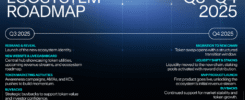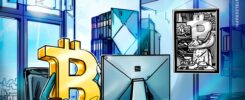Carlos Lee, CEO and co-founder of Uplink, a connectivity marketplace that uses decentralized physical infrastructure (DePIN) to allow telcos and enterprises to offload traffic on existing Wi-Fi and LAN networks.
We recently spoke with Carlos Lee about why the economics of connectivity don’t work — and how Uplink proposes a decentralized solution.
Carlos Lee is the CEO and co-founder of Uplinka DePIN company that is building a decentralized marketplace for communication. Their mission: to coordinate the world’s fragmented Wi-Fi infrastructure, enabling telecom providers and enterprises to leverage a global network of routers to offload data and deploy private networks.
His journey began in 2015 at a university in Porto — “Mish Valley,” he calls it — after years of developing advanced networking protocols at Hype Labs. The turning point came when he realized that the main challenge was not connecting devices to each other, but rather connecting the network itself to the Internet. This recognition led to a shift from a hardware to a software-first approach.
Below, Lei explains Uplink’s strategic vision, the rationale behind the migration to Avalanche, and what lies on the horizon.
I’ve worked in communications since 2015, starting with Hype Labs. What was the original idea – and how did it lead to Uplink?
In 2014-2015, my co-founder and I met at the University of Porto. The city is filled with Wi-Fi and research labs, so we delved into the networking and built the best protocols possible. Then the reality set in: getting one device online was difficult, and enterprise rollouts still took years.
I remember looking at one of the street lights in Lisbon running our network, linked through the building, yet the system was not active. From my Wi-Fi connected Airbnb, I stared at that column and thought, “What if we could use this Wi-Fi to connect to?”
The infrastructure is in place; It was simply fragmented. That’s how we built Uplink, a marketplace that connects millions of routers for use in communications.
To what extent did those early economic lessons, especially the unsustainability of building new infrastructure, push you toward the Web3 and DePIN model?
100%. To keep up with 5G demands, telecom companies must invest billions in new cell towers, which simply doesn’t make economic sense. As we explored ways to automate payment and billing processes for shared networks, we started looking at Web3. DePIN is an ideal use case because it solves the chicken-and-egg problem of building supply by creating incentives from day one.
You have been named one of Forbes’ Top 30 People Under 30. How did these milestones shape your vision as a founder?
To be honest, while this recognition is impressive and meaningful, I don’t think it has shaped me as a founder. It’s nice to see recognition for my team’s efforts, but these awards don’t define your company’s success. Sometimes I think it can be a curse, as people may fall into the “circus” and lose focus on the real work. Ultimately, awards are meaningless if you don’t have a profitable and growing company aiming to lead the market.
What are the biggest technical challenges you’ve faced in scaling this network, especially by focusing on software for existing hardware?
Our journey has been full of technical hurdles. We had two options. First: developing and selling our own hardware, which gives you control but means convincing millions of people to buy and deploy routers. Because what we were trying to achieve, it didn’t make sense. The second option: Create a program that works on all existing devices. This is very difficult. It took over two years of developing, failing, building partnerships, and learning – all while the technology continued to evolve rapidly.
You chose to build on the avalanche. What is the rationale behind this decision?
We were initially off-leash and just needed a tool. We looked at three things: transactions per second, community strength, and network uptime. We talked to some chains, but we really connected with the Avalanche DNA. They are very business focused and committed to the long term. I saw how they worked with companies and their level of professionalism, and we wanted to be associated with that. Avalanche’s latest upgrade also makes it an obvious choice for a company like ours.
Why is this new upgrade a game-changer for Uplink?
The amazing thing is what they call “cross-pollination of blockchains.” Instead of projects competing for resources, they can finally cooperate. In Web3, you have community partnerships, but on the technical side, it was the opposite; You are competing for stakeholders. Through this upgrade, our community and other project communities can work toward the same goals. Users who participate on our network may also participate for the benefit of others. It simplifies everything and creates a better dynamic between high-quality projects.
Many people may say: “I already have Wi-Fi.” What is the real problem that Uplink solves, and why is it urgent?
If telecommunications had not evolved, the connection you have today may be the best you will ever have. It is no longer possible for telecom companies to continue spending billions on new cell towers, especially since they do not provide good indoor coverage. The infrastructure already exists in existing Wi-Fi routers. Our goal is to bring these routers into our network so that carriers can do what is called “network offloading.” This allows your phone to automatically connect to a nearby router instead of a cell tower, without you even noticing. You get faster speeds, lower cost connections, and you’ll get better service. We are the market that makes this happen.
How are companies using Uplink today?
We have many solid examples, plus more we can’t announce yet. We have connected an entire city where telecom companies are actively offloading the network. In South America, a large organization has been using our network for two years – they save significant money and get much faster speeds compared to their previous SIM cards. We’ve been very active with these enterprise customers as we prepare to open this to the world.
How does your token model work with ULX incentives and network credits?
It’s a simple burn and mint system. We have the ULX token, which is the main tradable asset, and the network balance, which has a fixed value. The primary purpose is for users to consume data. For example, if 100GB costs $100 and $1 equals 1 Network Credit, the user must burn the ULX amount equivalent to 100 Network Credits. This allows the value of ULX to fluctuate while keeping service prices stable for our business customers. ULX also rewards connectivity providers and community members who help map and verify the network.
What are the next big growth opportunities for Uplink? What should people expect?
The technology is mature, and we are now focused on real revenue and growth. The next step is our TGE event, which we expect early next year. That’s when the network becomes fully live and open to the world. We’re at the point where we need to prove that technology can scale and generate sustainable revenue. Once we reach these milestones, we will open it to everyone.





